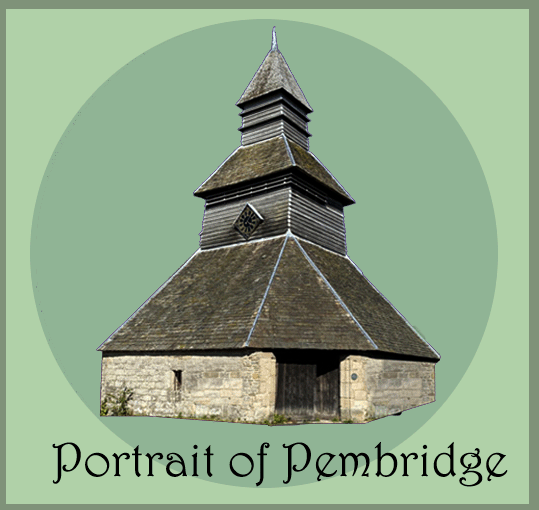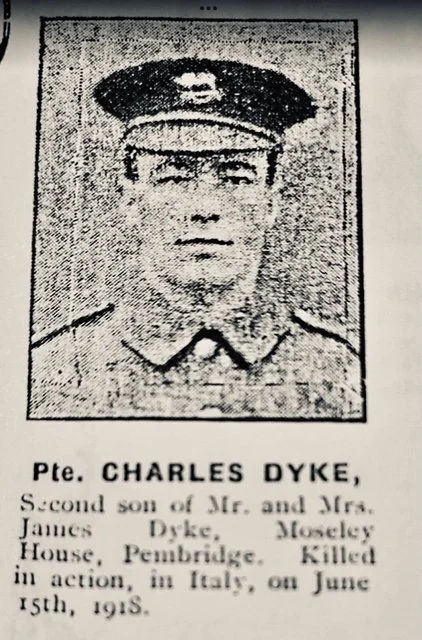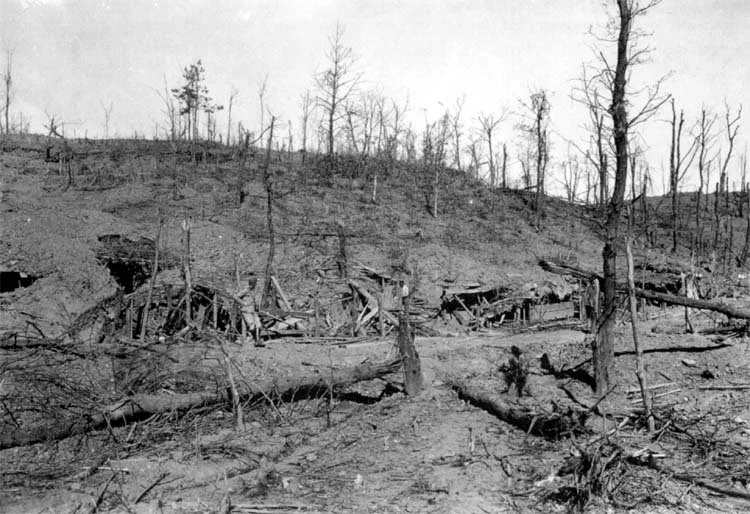Charles Dykes, Private, 1st/ 5th Battalion Gloucestershire Regiment
Joseph Dykes, Driver, Royal Field Artillery
Above photo: Charles Dykes
The 1891 census states that Charles Dykes was born in that year in Almeley, Herefordshire to James (37) and Martha Dykes (28). At the time of his birth, he had a brother, James, aged 3.
In the 1901 census, James Dykes, along with his wife Martha, sons James and Charles and two more additions to the family, Joseph, born in Almeley, in 1893, and young Martha, born in Pembridge in 1895, are all now living in West Street, Pembridge. Their dwelling comprises 4 rooms (including kitchen). Charles was ten years old at the time of this census. Charles’s and Joseph’s father, James, is described as an agricultural labourer and a waggoner. A waggoner was entirely responsible for care of horses under his control and attended to the watering, feeding and bedding of the horses as well as harnessing them and driving them in accordance with whatever work was to be undertaken - ploughing, reaping, harrowing and carting.
In the 1911 census, neither Charles or James are living in Pembridge, only their parents and Martha, their younger sister, who is now 16, residing there. It is difficult to ascertain where either Charles or Joseph Dykes were living that year,
From what is known about Joseph Dykes’s war experience, he was with No. 2 Depot, Royal Field Artillery. No. 2 Depot was a home based unit of The Royal Field Artillery stationed at Preston, Lancashire.
“As a home based unit, it’s role would be
1/ to train new recruits
2/ for providing mobile artillery in the case of enemy attack
3/ providing mobile artillery in the case of insurrection as was the case with The Easter Uprising in Dublin in 1916
4/ To protect both key ports and coastal installations” (1)
So, it would not appear that Joseph Dykes saw active service on the continent or elsewhere as according to “The Army Registers Of Soldiers Effects”, Joseph Dykes died of “disease” in Preston on 17th February 1917, aged 24. This register states that he left the sum of £2 10s 8d (back pay) to his father, James Dykes.
Charles Dykes enlisted in Leominster in 1915 in the Herefordshire Regiment possibly under the Derby Scheme.
“Derby's Scheme was a survey to determine how many could be obtained, via the use of appointed canvassers visiting eligible men at home to persuade them to 'volunteer' for war service. When the scheme was announced, some went to the recruiting office immediately, rather than wait for the inevitable. Many canvassers were experienced in politics, though discharged veterans and the fathers of serving soldiers proved the most effective, while some just used threats to persuade. Although women were not allowed to canvas, they did contribute by tracking men who had moved address. Each man would be given a copy of a letter from the Earl of Derby, explaining the programme and rather dramatically stating that they were in "a country fighting, as ours is, for its very existence". Faced with the canvasser, each man had to say whether or not he would attest to join the forces; no one was permitted to speak for him.
Those who did agree to attest had to promise to present themselves at their recruiting office within 48 hours, while some were accompanied there immediately to make sure.” (Wikipedia)
The Herefordshire Regiment was one of the smallest regiments in the country. It is more than likely that once Charles Dykes had enlisted, he found himself in the 2nd/1st or 3rd/1st Battalion of The Herefordshire Regiment.
“The 2nd Battalion was formed on 22 August 1914, and at that time comprised the small Hereford Depot staff and the hundreds of volunteers that had enlisted. The battalion became an operational Battalion allocated to UK Home Defence. It never served overseas.
“As things settled down many of these men were transferred as reinforcements to the 1st Battalion, Herefordshire Regiment and other units to make up the numbers.” (2)
Above photo: Troops of the Herefordshire Regiment on a training ‘route march’ (3)
The 3rd/1st Battalion was formed in Autumn 1914 again to handle the large number of volunteers. It became the Depot & Training Battalion for the Regiment, training new recruits and receiving soldiers returning to fitness after wounds and sickness before posting them to an operational unit.” (4)
Above photo: The Herefordshire Volunteer Battalion on Exercise (5)
At some point Charles Dykes was posted to the 1st/5th Gloucestershire Regiment, 145th Brigade, 48th South Midland Division. It is plausible that he was posted to this battalion after 23rd July 1916 when, on that date, the 1st/5th Gloucesters went over the top into murderous machine gun fire during the main attack at the Battle of Pozieres, the battalion being driven back with the loss of 13 officers and 125 men. Given that the 1st/5th Gloucesters would by then have been in need of reinforcements to replace those killed and injured, Charles Dykes might well have been one of these replacements. If the time period is correct with regard to Charles Dykes’s posting then he would have seen action at the Battle of Languemarck with the 1st/5th Gloucesters when this battalion was moved to the Ypres Salient that same month to take part in the Third Ypres Offensive.
During the Battle of Langemarck (16–18 August), 1st/5th Gloucestershire Battalion took part in 145th Brigade's difficult attack on a German strong point built into the most northerly house in the village of St. Julien. The advance then met a heavy crossfire as the leading wave topped the rise of ground about 200 yards (180m) east of the River Steenbeck.
Above photo: River Steenbeck, 3rd Ypres Offensive (IWM)
Further attempts to advance only resulted in additional casualties.
Above photo: The Battle of Langemarck, 3rd Ypres Offensive, 1917 (IWM)
The battalion dug in and held on against determined counter-attacks. By the end of the action the 1st/5th Gloucestershire Regiment had lost 8 officers and 209 other ranks killed and wounded; only four front line company officers survived Langemarck.” (Wikipedia)
On 10 November 1917, the 48th (South Midland) Division received orders to transfer to the Italian Front and the move began on 21 November.
The following describes the part that Commonwealth forces played on the Italian/Austrian Front.
“The Italians entered the war on the Allied side, declaring war on Austria, in May 1915. Commonwealth forces were at the Italian front between November 1917 and November 1918. In March 1918, XIV Corps (the 7th, 23rd and 48th Divisions) relieved Italian troops on the front line between Asiago and Canove, the front being held by two divisions with one division in reserve on the plain. The French held the line to the left, with the Italians to the right. The front was comparatively quiet until the Austrians attacked in force from Grappa to Canove in the Battle of Asiago (15-16 June 1918).” (CWGC)
Above photo: Aerial View over the Asiago Plateau, Italy, 1918 (Wikipedia)
“On 15 June the Austrian-Hungarian army made what proved to be its last attack. The 48th, South Midland Division, had been particularly hard-hit by the Spanish flu epidemic, and the 1st/5th Gloucestershire Battalion was only about 490 strong; the brigadier had hesitated whether it should even take its place in the line. The attacking Austrians got through the weakly-held outposts in the woods and then outflanked the main defences to reach 1st/5th Battalion’s HQ. The battalion HQ staff, cooks, signallers, drivers and batmen made a stand, holding on until one of the companies came round the enemy flank, and were then rescued by the arrival of another brigade. The battalion's casualties amounted to 11 officers and 138 other ranks killed and missing, with nine officers and 64 other ranks wounded; its desperate stand was rewarded with a DSO, two MCs, one DCM and six MMs.” (Wikipedia)
Above photo: The remaining Alpine vegetation after The Battle of Asiago (Wikipedia)
It was during this attack on 15th June, 1918, as described in a war diary - “War In The Air” by H. A..Jones that Charles Dykes was killed in action.
He was 27 years old.
“15th June 1918 Austrian attack. At dawn on the 15th June 1918 the British Divisions at the western end of the Italian front came under sudden attack from Austrian troops. The assault in fact covered the whole Italian front from the Alps to the sea. It was known later that the Austrian command had taken great precautions to conceal their intentions by keeping attacking divisions well behind the lines and they were only sent forward into their battle positions early on the morning of the attack. Repeated reconnaissance flights by Italian and RFC (Royal Flying Corps)patrols had failed to see the build up of forces.
There was rain and mist on the morning of the 15th and the RFC pilots could do little to help the British Army. In the afternoon, when the weather in the mountains became even worse, the squadrons of the Royal Air Force were diverted to assist the Italians on the Piave river where the flying conditions were somewhat less unfavourable. The Austrians had attacked the Italians under cover of smoke screens and, accompanied by low-flying aeroplanes, they had quickly succeeded in crossing the Piave, following which reinforcements of fresh troops had pushed forward south of the river.
Above photo: Asiago in ruins (Wikipedia)
The first news received by the British that the Austrians were crossing the Piave opposite the Montello had been brought in at 11.40 a.m. by the pilot of a Sopwith 'Camel' returning from routine patrol. Three 'Camels' of No. 45 Squadron then left at 12.30 p.m., followed by three more at 12.40 p.m., and by three at 1.05 p.m. They each carried four 20-lb. bombs which were aimed at pontoon boats. One hit a pontoon loaded with men, and another destroyed a boat leaving the shore: troops were also attacked with machine-gun fire. The pilots reported that the Austrians were crossing the Piave in great numbers at several points. Every available British aeroplane was called to help the Italian Army. By 4 p.m. there were thirty-three Sopwith 'Camels' supplementing the work of the Italian air service by attacks on bridges, rafts, boats, and Austrian troops in the Piave sector. Captain W. G. Barker of No. 66 Squadron, who took part in the attacks, recorded: “The Austrians had been successful against the Italians. They had succeeded in crossing the Piave opposite the Montello. The Montello, owing to its height, dominated the Venetian plain and under its cover they had thrown two pontoon bridges across the river. The leader selected the bridge farthest upstream and individual bombing commenced from about 50 feet. This bridge was quickly broken in two places and the pontoons, caught by the fast current, were immediately dashed against the lower bridge, carrying it away also. When this attack commenced these bridges were crowded with troops which were attacked with machine-gun fire. Many were seen to be in the water. This done, troops on small islands and in row boats were machine-gunned.” (6)
The Allied line was penetrated to a depth of about 1,000 metres on 15th June but the lost ground was retaken the next day and the line re-established. Between June and September, frequent successful raids were made on the Austrian trenches.
Charles Dykes is buried at the Magnaboschi British War Cemetery near Vicenza, Italy.
Above photo: Magnaboschi War Cemetery (CWGC)
“Magnaboschi British Cemetery is one of five Commonwealth cemeteries on the Asiago Plateau containing burials relating to this period. It contains 183 burials of the First World War. This includes Special Memorials of which the burials cannot be individually identified.” (CWGC)
Charles Dykes’ headstone is engraved with the words “PEACE PERFECT PEACE” which were the wishes of “Mrs M. Dykes, Moseley House, Pembridge” (CWGC)
Moseley House, Pembridge is situated about 70 metres to the left of The Byletts.
Above photo: Moseley House, today (7)
Below is a headstone at Pembridge St Mary Churchyard where Joseph Dykes is buried along with another commemoration of his brother, Charles.
Above photo: Charles Dykes’s headstone and grave (Lee Oxenham, CWGC)
Rory MacColl
Sources
1/ https://www.longlongtrail.co.uk/army/regiments-and-corps/the-royal-artillery-in-the-first-world-war/royal-artillery-depots-training-and-home-defence-units/
2/ https://herefordshirelightinfantrymuseum.com/wars/wwi/
3/ https://herefordshirelightinfantrymuseum.com/uploads/1914-sep-regtl-history.pdf
4/ https://herefordshirelightinfantrymuseum.com/wars/wwi/54/
5/ https://herefordshirelightinfantrymuseum.com/wars/wwi/
6/ https://www.wartimememoriesproject.com/greatwar/greatwar-day-by-day/viewday.php?dey=15&mth=June&year=1918
7/ https://media.onthemarket.com/properties/3959144/1165043539/document-0.pdf













